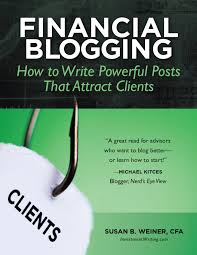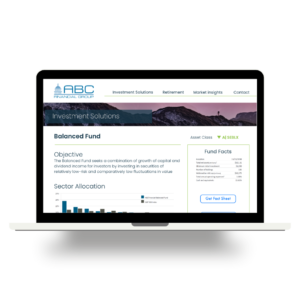4 Tips for Turning Investment Commentary into Blog Posts
 As the role of blogging in asset management marketing grows, firms struggle to generate effective content. This is why it’s great to exploit your investment commentary on your blog. However, some pieces of investment commentary weather the leap to your blog better than others. Make the wrong choices and you’ll fail to attract readers. You’ll also turn off those who already navigate to your website. I have four main tips for asset managers who want to get more mileage out of their investment commentary by turning them into blog posts.
As the role of blogging in asset management marketing grows, firms struggle to generate effective content. This is why it’s great to exploit your investment commentary on your blog. However, some pieces of investment commentary weather the leap to your blog better than others. Make the wrong choices and you’ll fail to attract readers. You’ll also turn off those who already navigate to your website. I have four main tips for asset managers who want to get more mileage out of their investment commentary by turning them into blog posts.
1. Be provocative—or at least express an opinion
You’re competing for attention with many fast-breaking news sources so don’t rehash information that’s already out there. You’ll lose readers quickly if you start with “The S&P 500 rose x.x% and the Barclays Capital Aggregate Bond Index rose fell y.y%.” They can get that information in many places. Sure, you must include this data in your quarterly commentary or weekly economic statistics roundups, but don’t focus on it in your blog posts.
Instead, interpret the data and make it relevant to your readers. Readers care most about the WIIFM, what’s in it for me. Explain how the market’s movements affect your outlook and the way that your readers invest. For example, should readers consider a tactical move in their portfolios or can they rest easy, assuming your outlook is on target? Of course, as with your regular investment commentary, check with your compliance and legal experts to make sure you don’t promise too much.
2. Focus on one theme—and keep it short
Online readers are looking for solutions to their problems. Compared with readers of printed materials or even clients viewing your emailed commentary, they’ll quickly abandon your writing if you don’t offer a solution. Being provocative isn’t enough. You need to focus on the one area that they care about.
Let’s say a reader is assessing whether to increase a portfolio’s allocation to emerging-market bonds. You don’t have much time to win them over. The typical online reader makes an initial assessment of a page in less than one second, according to the Nielsen Norman Group’s How People Read on the Web: The Eyetracking Evidence. If emerging-market bonds aren’t highlighted in your title and introduction, the reader will move on. Once you draw in readers, you have to keep them engaged. Research by the Poynter Institute found that people averaged only 78.3 seconds on the first story that they chose to read but did not complete when using iPads.
With such short attention spans, I believe you should keep your blog posts short. When I teach financial advisors who aren’t seasoned writers how to blog, I encourage them to write posts that run 250 to 400 words in length. A non-professional writer can’t go too far wrong in such a short piece.
If you are a strong writer who maintains focus on a single topic, you can go longer. This is especially true if you follow my next tip.
3. Write posts that are easily skimmed
Many readers skim instead of reading word by word. Make it easy for them by using powerful headings and strong topic sentences. Readers will stick with you longer if they can scan your headings to find the content that’s most appealing to them. This means they don’t have to slog through every word to find the relevant section.
Write informative headings that convey each section’s point. For example, I didn’t call this section “Skimmability.” Instead, I gave you a tip.
Starting each paragraph with a strong sentence that conveys the paragraph’s main topic also enhances skimmability. I suggest that you test your blog post with the “first-sentence check,” which I’ve described in my book, Financial Blogging: How to Write Powerful Posts That Attract Clients.
4. Write like a human being, not an institution
Blogs are less formal than most communications traditionally issued by investment management firms. They take a more conversational approach. This is especially true if you’re targeting individuals instead of institutional investors. Many of the most appealing blogs directly address “you,” the reader and may even refer to the author as “I.”
Of course, “I” may be a step too far for investment firms emphasizing team management of portfolios. But even using “we,” investment managers can use some of the techniques I discuss in “How to add personality and warmth to your financial writing–Part one” and “Part two.”
Bonus tip: Don’t share PDFs
Want to annoy your readers? Ask them to download a PDF file from your blog to read your commentary. Blog readers don’t want to take extra steps to access your content.
If you must include a link to PDF, don’t make that link the focus of your post. Instead, write an intriguing introduction to that PDF so readers get some value before they click.
If you want to improve your blogging skills…
…check out my book, Financial Blogging: How to Write Powerful Posts That Attract Clients, available in paperback or as a PDF.
 Here’s what one portfolio manager says about it: “I wish I had read Susan’s Financial Blogging before I produced 300 weekly posts. There was a lot of practical advice in a slim 137-page guide to producing effective blogs. The blog preparation work sheets should be of particular value to an author who wishes to get smart people to do smart things with their money. Compliance concerns become a hurdle, not a wall, between prospect and the provider of financial services. My posts will be better for having read the book.”
Here’s what one portfolio manager says about it: “I wish I had read Susan’s Financial Blogging before I produced 300 weekly posts. There was a lot of practical advice in a slim 137-page guide to producing effective blogs. The blog preparation work sheets should be of particular value to an author who wishes to get smart people to do smart things with their money. Compliance concerns become a hurdle, not a wall, between prospect and the provider of financial services. My posts will be better for having read the book.”
Did you like this post? Please share! You can also subscribe to our blog.
Here are some related resources that might interest you:






 Compare the Top 3 Finserv Content Automation Vendors [White paper]
Compare the Top 3 Finserv Content Automation Vendors [White paper] Create Pitchbooks the Drive Sales [White paper]
Create Pitchbooks the Drive Sales [White paper] Build vs. Buy: Should Your Financial Services Firm Outsource or Insource Marketing Technology? [White paper]
Build vs. Buy: Should Your Financial Services Firm Outsource or Insource Marketing Technology? [White paper]  10 Tips for Rebranding your Fund Marketing Documents [White paper]
10 Tips for Rebranding your Fund Marketing Documents [White paper]




